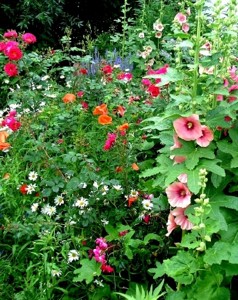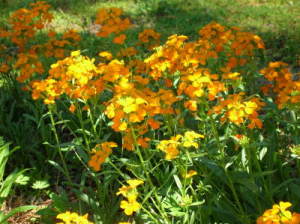
For the busy gardener, the idea of a flower garden that sows itself is pretty appealing. The idea of a garden that sows itself AND saves you money sounds almost too good to be true. Self-seeding annuals (and some biennials and perennials) are more than up to the task. In fact, they are the perfect flowers for the job. That's because nature has already designed them to be prolific bloomers and mass producers of seed.
The most inexpensive way to start a self-sowing garden is by seed (you can also start with plants and save the seed). There are two ways to do this. The first way (for you adventurous types) is to scatter your seeds willy-nilly all over a prepared bed. This is a wonderful "wait and see what you get" kind of approach, which is sure to garner some delightful, if not surprising, results. This approach also gives you the advantage of not having to weed until you learn to identify your flowers from those less desirable "flowers that are just out of place."
The second way (for you more conservative types), is to outline a bed and mark off different sections within the bed for sowing each type of seeds. This results in a little more formal look (at least for the first year), and will give you a better opportunity to "edit" (but less excuses to leave the weeds). Plants tend to lean forward (and over the edges of your carefully marked bed) before dropping their seed. Bend them back to where you want your seed to fall, or once spring rolls around you'll be transplanting seedlings from over the border.
Once the seedlings are tall enough, start adding a protective layer of mulch around them to cover the soil and help control weeds.
Self-sowing annuals have a lot of flower power. Take advantage of this by deadheading them to encourage continuous blooms until mid to late summer. After that, let some of the flowers go to seed.
Many gardeners choose a more deliberate approach to self-sown gardens by collecting and saving seeds each fall and sowing them directly by hand in the spring. This works well as long as you provide the seeds with the conditions they need to germinate. Some seeds need light to germinate (should not be covered with soil), while others prefer darkness. Many annual seeds will germinate faster if scarified or soaked in water. Others need a period of cold to trigger germination.
One thing to keep in mind when selecting plants and seeds is whether or not they are open-pollinated or hybrids. Open pollinated seeds (like the heirloom varieties) will always produce offspring identical to their parent, which is wonderful if you're going for a certain look or trying to maintain a specific color scheme. Hybrid seeds may produce offspring which look vastly different from their parents. This can be exciting if you like surprises and enjoy seeing a different look each season.
This is just a partial list. Don't forget about plants that are native to your region.

About The Author: Ellen Brown is an environmental writer and photographer and the owner of Sustainable Media, an environmental media company that specializes in helping businesses and organizations promote eco-friendly products and services.
Add your voice! Click below to comment. ThriftyFun is powered by your wisdom!
We have had great luck with forget me nots self seeding, so much so that we've had to divide off sections and give them to other people.
It's important to plan out where all your flowers will go and how the colors coordinate, so I'm not sure I could do the random scattering approach. Here's a good read on planning:
www.oldhouseweb.com/
Each spring I have a huge round brick bed of beautiful bluebonnets with their pretty gray-green foliage. As the seed pods dry, they twist, naturally expelling the seeds. Just let the seeds lay on the ground. When the pods are all empty, pull up the foliage and plant annuals for summer right on top of the seeds. They begin to sprout immediately, but stay very small throughout the summer. These self-seeding beauties save me a ton of money! I'm in Zone 8a.
Great list! I have a bunch of those in my own cottage garden. Here are a couple others I've had a delightful time watching self-seed year after year: English wallflower, gaillardia, and ordinary marigolds. (I'm in Zone 7--that may make some difference.) An added bonus: bees and butterflies LOVE wallflower (pictured). It's very fragrant as well as vibrantly colored.

The same principles apply for some vegetables. We have had excellent luck with lettuce, tomatillo, India mustard and potatoes. Plus, strawberries send out runners that you just have to replant into a row. Our self-sown crops are the earliest ones, generally speaking, as well.
I live in zone 8, in N Texas. I have one flower bed, that I call the desert flowerbed, because it doesnt have any sprinklers near it. To be placed in this bed, a plant must be very drought resistant. I find that four oclocks self seed quite well. Zinnias, dont sadly. Marigolds are great to plant in the same pot, or close by tomatoes. If I see a dried flower head on my marigolds, I just crumble it up into my tomato container, and pretty soon, more marigolds are coming up!
Add your voice! Click below to comment. ThriftyFun is powered by your wisdom!